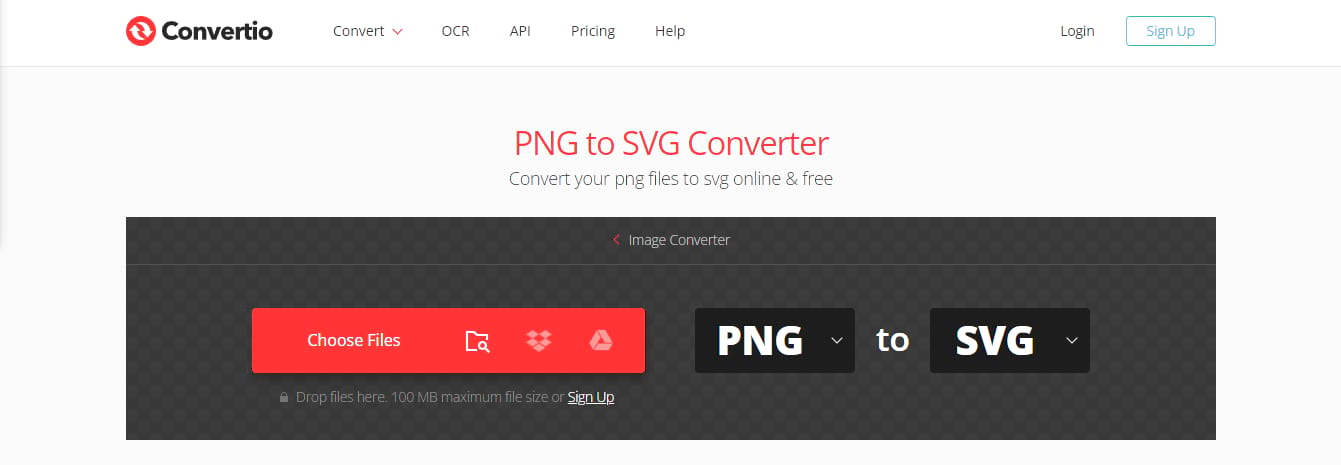There are dozens of image file types, each varying based on compression type, formatting, and browser support. But two of the most commonly used are SVG and PNG formats.
These two file types couldn’t be more different — each is better suited for specific situations. They’re certainly not interchangeable in every aspect, but you may find that SVGs can perform specific tasks better than the standard PNG image.
Learn the difference between SVG and PNG and where best they’re applied on your website.
Check Out Our Video Guide to SVG vs PNG
What Is SVG?
SVG stands for Scalable Vector Graphics, and it’s the most widely used vector file format on the web. Let’s break this down:
- Scalable: SVGs can be resized up or down without damaging the quality of the image. It will be perfectly crisp and clear, no matter how large or small it is.
- Vector: Most image file types contain pixels. Vectors are essentially pieces of code that render an image in real-time, converting it to the pixels you see on your screen. While they display the same image, what goes on in the background is very different.
- Graphics: Though it may not be as well known, SVG is an image file type like PNG, JPEG, or GIF. It just goes about things a little differently.
Vectors are pieces of code written in XML that represent shapes, lines, and colors to elaborate on how it works.
While creating an image with nothing but code is entirely possible, most people use a vector graphics editor like Inkscape or Adobe Illustrator. You can also convert PNGs or other raster images to SVG, but the results aren’t always great.

When the page loads, this code is converted into graphics, so you can’t immediately tell an SVG from a PNG. But because SVGs are simply lines of code converted to pixels, that means they can scale to any resolution — large or small — without losing quality.

SVG also supports animation and transparency, making it a versatile file format.
The only issue is that it’s not as widely used as more standard formats like PNG, so it’s less supported on older browsers and devices, and it’s not always the easiest to upload it to your site and get it to display correctly.
Pros and Cons of SVG
Though still not as widely used as raster file types like PNG, vector graphics are growing fast in popularity. They do some essential tasks that raster images just can’t. Here’s why people love SVGs.
- SVG images are scalable. You can design it at any resolution, and it will size up or down without damaging the quality or becoming pixelated. With raster images, you need to know what size you want from the beginning, or you could risk making the image too large or too small.
- SVGs always look crisp and beautiful due to never experiencing quality loss. Raster images can start to look blurry when even slightly resized.
- As SVGs are just code, their file size is minimal and well-optimized. SVG optimizers also exist to make them even more manageable. Your site will likely load a little faster if you use them instead.
- Unlike PNGs, SVGs support animation.
SVG has quite a bit on PNG, from being scalable to tinier in size, but it’s not better in every situation. Here’s the bad of vector file types.
- While SVGs enjoy support on all major, modern browsers, you can run into compatibility issues rendering them on older browsers and devices. If a significant chunk of your visitors uses those, switching over could be a bad idea.
- SVGs are harder to work with, requiring special programs to create and edit. While you can design them with nothing but XML, this isn’t always feasible. Premium tools like Adobe Illustrator can be expensive.
- SVGs aren’t nearly as easy to embed as PNGs. If you’re using WordPress, it isn’t supported by the default media library, so you’d need a plugin to upload them at all.
- SVGs must be rendered by the browser when the page is loaded, so using an excess of them or a large file with many vectors can tax the device.
When to Use SVG Over PNG
While you definitely shouldn’t convert all your PNGs to SVGs, vector graphics can make an excellent replacement for some images.
SVG images work exceptionally for decorative website graphics, logos, icons, graphs and diagrams, and other simple images. See our homepage for an excellent example of vector artwork in action.

However, they don’t work as well with complex images involving many colors and shapes, such as screenshots, photography, and even detailed artwork. While it’s possible to convert any image to SVG, browsers don’t always handle complex vectors with hundreds of colors well since they have to be rendered when the page loads.
In addition, SVG artwork can be beautiful, but designing complex images requires a lot of time, effort, and proficiency in advanced editing tools. Keep it simple if you want to create your vector images.
If you have detailed images, definitely stick with PNG.
However, SVGs are better for responsive and retina-ready web design due to their scalability and lack of quality degradation. In addition, they support animation while PNG doesn’t, and raster file types that support animation like GIF, APNG, and WebP all have their issues.
For simple graphics that may require animation and are guaranteed to scale well on any screen size, use SVG.
What Is PNG?
PNG stands for Portable Network Graphics, and this name is reflected in how widespread this file type is. Anyone who’s ever used a computer has likely worked with PNGs, as it’s the most common file type on the internet next to JPEG.
PNG is a raster image file type, similar to most common image formats. That means that it consists of pixels, the same small dots displayed on your monitor or screen. While this makes it easy to display, it also means image quality is dependent on the resolution — how many pixels are in the image.
So if you scale a raster image up or down in size, the quality will be impacted. Sometimes the damage is negligible, especially when scaling down, and sometimes it can make an image blurry and completely unusable.

Still, the prevalence of PNG makes it a good candidate for general-purpose usage. This file type supports transparency, but not animation.
Pros and Cons of PNG
What makes PNG the most widely used image file format online? Here are the advantages:
- PNG files are easily editable and opened in any common image editing tool. There’s no need to pay for advanced programs to create or change a PNG image; at most, you may need to download a free editor like GIMP.
- Whether you’re coding from scratch or using the WordPress media manager, displaying PNG images on your site is a simple task.
- PNG uses lossless compression that leaves it looking crisper than lossy compression JPEGs. However, this does come at a larger file size cost, and it can’t compare to vector images.
On the other hand, the PNG format was created decades ago and has several notable flaws that haven’t been updated for the modern era.
- You cannot resize PNG files without losing quality. You need to plan carefully when designing raster graphics and make sure it’s the right size, or you may end up wasting time making unusable images.
- PNGs are very large due to their lossless compression. Thus, they can slow down your website. Fixing this requires compressing it even more and damaging the quality.
- Making images “retina-ready” is more tedious with PNGs and more likely to cause blurriness.
- PNG does not support animation. Other animated raster file types like GIFs can have serious problems; for instance, GIFs are super low quality and only support 256 colors.
When to Use PNG Over SVG
PNG is the most common file type for a reason; it’s highly versatile and fits almost any situation. There are just a few flaws to consider when using it, like their large file size and lack of scalability.
PNGs are suitable for displaying detailed images, artwork, and photography — everything a vector image can’t handle. Anything with hundreds of colors and a large resolution should likely be a PNG.
That’s not to say you cannot use PNGs for more straightforward images like logos and decorative graphics, but SVGs would be better suited for the task.
When you’re not sure whether a platform will handle the newer, less supported SVG file type, PNG is the way to go — if only to be safe.
For instance, you can’t upload SVGs to most social media. And as some email clients may struggle with vectors, it’s usually recommended to stick with PNGs in email templates.
In general, PNGs work well with any complex, non-animated images, especially ones that require transparency. You can use it pretty much anywhere; it’s just that sometimes an SVG would be a better fit.
Remember that you can always use PNG fallbacks if your SVG fails to load, so it’s usually safe to go with vectors even if a significant portion of your user base has stuck with older devices or browsers.
Which Is Best: SVG or PNG?
Neither file type is better or worse than the other; each has its limitations. Though SVG outperforms PNG in several areas, PNG is a lot better at handling certain things.
In general, though, you should stick to SVGs wherever appropriate and use PNGs in all other situations that vectors cannot handle. You may be technically able to use either in these cases, but SVG is preferable in a few specific areas.
While SVG supports animation, PNG does not. Raster file types like GIF and APNG can be considered alternatives. Still, there is no perfect animated raster format that’s widely supported, well known, high quality, and results in small file sizes. SVGs satisfy all these niches.
SVGs also scale perfectly to any screen size, making them responsive and retina-ready by default. PNGs will lose quality when resized, and getting them to scale well is a hassle — especially if you only have tiny images that won’t display well on large screens.
Finally, SVGs are generally smaller than PNGs, so they’re less taxing on your server despite needing to render on load.
Use them for simple, flat color artwork, logos, and decorative graphics on your site.
On the other hand, PNGs are suitable for displaying complex graphics at a large resolution, or pictures with thousands of colors. SVGs can’t handle that amount of colors and shapes at the moment.
These sort of complex images will often make up the majority of pictures on your site, so it’s not time to toss out PNG yet.
And PNGs are more widely supported on browsers and specific platforms like email clients. If you’re not sure whether an SVG will render properly, err on the side of caution and use a PNG.
Summary
SVG and PNG are two very different file formats. In the end, it’s not a big deal whether you use PNGs or JPEGs on your site outside of very niche use cases, but picking between SVG and PNG is a much more important choice.
You’re far more likely to use PNGs as it’s a simpler, easier to access, and more versatile file format. Complex images such as screenshots and detailed illustrations should use PNG.
While SVGs are harder to create and edit, they have a variety of benefits over PNGs. Whenever it’s appropriate to use vector images, such as decorative graphics and logos, definitely use SVG.
You won’t likely be swapping out every single image on your site for an SVG, but their responsiveness and smaller file sizes make them a great candidate in certain situations.
Are you SVG or PNG gang? Please share your views with our community in the comments below!


